Chords of the Major Key
There is a formula to determine which chords are Major and which are Minor (and one Diminished)
If you remember the Major Scale, the Key Formula follows the Major Scale: W-W-H-W-W-W-H
The formula is Major-Minor-Minor-Major-Major-Minor-Diminished
You may see it writen in the following manor: I - ii - iii - IV - V - vi - viiº
These are the Roman Numerals of the positions. The capital letters are Major, and lowercase is Minor.
The final chord, the 7 position is Diminished, which simply means we flatten the 5th of that chord.
Any of these chords can either be their respective Major or Minor, but also their Seventh (e.g.: A Major, or A Major 7th).
We'll cover the Major Key, and also give you some hints on how they are laid out on the fretboard.
The Key of A Major
In this case, we'll look at the Key of A Major. The notes of the A Major Scale are (A,B,C#,D,E,F#,G#)
thus the roots of these chords will be the same as the notes of the Major Scale.
Using the formula: I - ii - iii - IV - V - vi - viiº, we can determine the chords of A Major.
Remember that any chord can be substituted by its 7th chord.
The root, or I chord is Major, thus the first chord is A Major or A Major 7th
The ii chord is Minor, thus: Bm or Bm7, and so on.
Here is the list of chords for the Key of A Major.
- I – A Major, A Major Seventh (Amaj, Amaj7)
- ii – B minor, B minor seventh (Bm, Bm7)
- iii – C# minor, C# minor seventh (C#m, C#m7)
- IV – D Major, D Major Seventh (D, Dmaj 7)
- V – E Major, E Dominant Seventh (E, E7)
- vi – F# minor, F# minor seventh (F#m, F#m7)
- vii° – G# diminished, G# minor seventh flat five (G#°, G#m7b5)
The "L" Pattern
There is another way to determine the chords of a Major Key on the fly, while you're playing the guitar.
It's called the "L" pattern.
In the L Pattern, you find the root note, similar to how you find the root note while playing Barre Chords.
For this example, we're continuing our dive into the Key of A Major. So, A will be the root of the root chord.
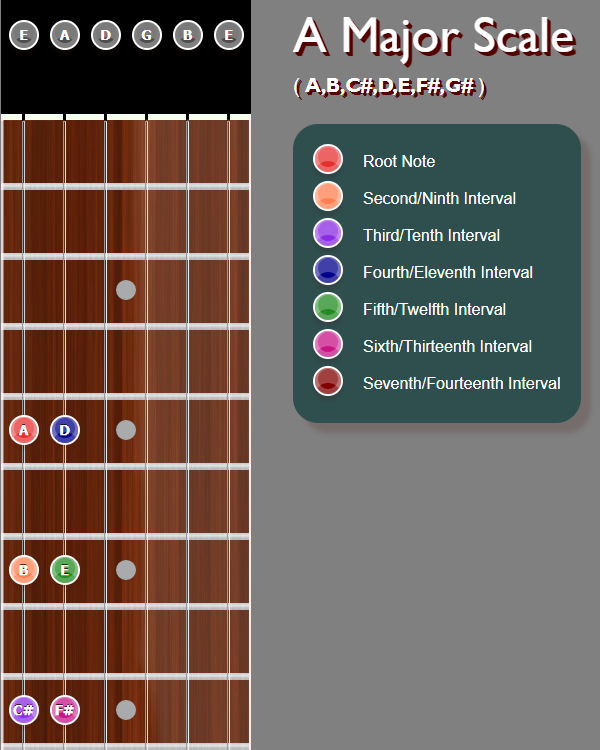
As we discussed above, the Major Chords are the I - IV - V and the Minor Chords are ii - iii - vi.
So, using the layout of the neck we mark the Major Chords in yellow, and the Minor in Orange.
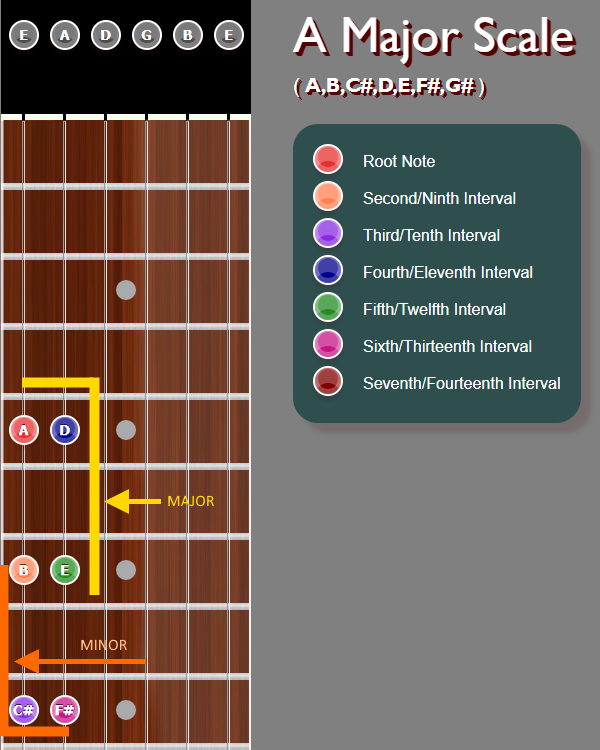
You might notice that the pattern creates 2 Ls. One upside down for the Major, and another for the Minor Chords.
This is the L Pattern. Upside down is the Major 1-4-5, and the other is Minor 2-3-6.
As with most guitar patterns, it is absolutely moveable up and down the neck.
This pattern works anywhere on the neck with the root on the 6th, 5th, or even 4th strings.
Another way to use the "L" Pattern
Another way to use the "L" Pattern, is to have your Major Chords, like above,
and move the the pattern down 3 frets. In our example of the A, and move the pattern
down 3 half steps (3 frets) from A to F#.
The pattern shows you the Minor Chords in the Minor Key. In this example, the F# Minor Key,
The Minor Keys are F#m, Bm, C#m.
Then to find the Major Chords of a Minor Key, you move the pattern up 3 frets. The Major Chords
of the F#m Scale are A Major, D Major, and E Major.
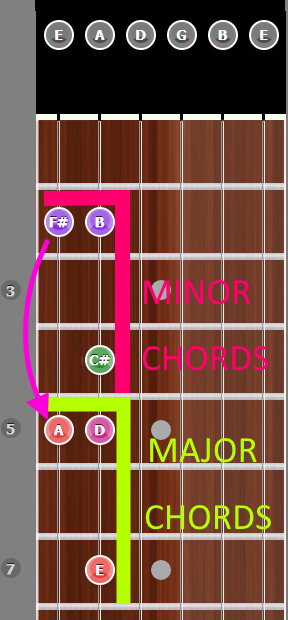
But We're Missing One Chord
The L Pattern gives us an easy way to determine the Major and Minor Chords of a Key.
But, that's only 6 chords. There's one more, 7th interval. The Diminished Chord. How do we find that?
To find the 7th in a Major Key, you simply move 1/2 step down from the root note.
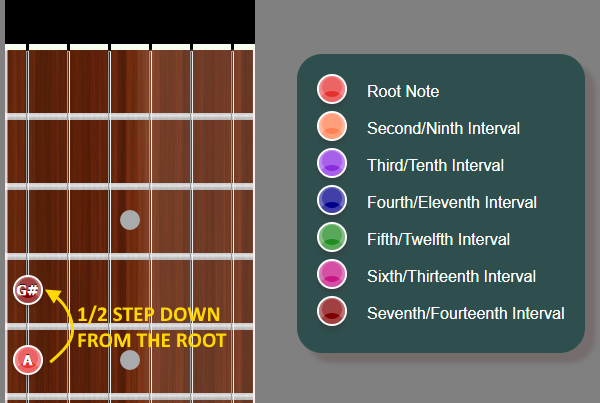
In this case, our 7th is G#, and since the 7th chord interval is diminished, we get a G#º.
To find the 7th in a Minor Key, you move up 2 frets (a full step) from the root note.
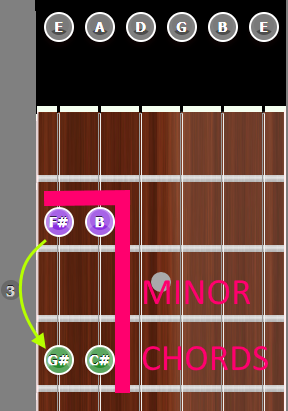
Why is this a diminished chord?
As stated in the Chord Formula tutorial, a diminished is a chord with a flattened 5th.
Here are the notes of the A Major Scale, along with the G# one step one step down from the root.
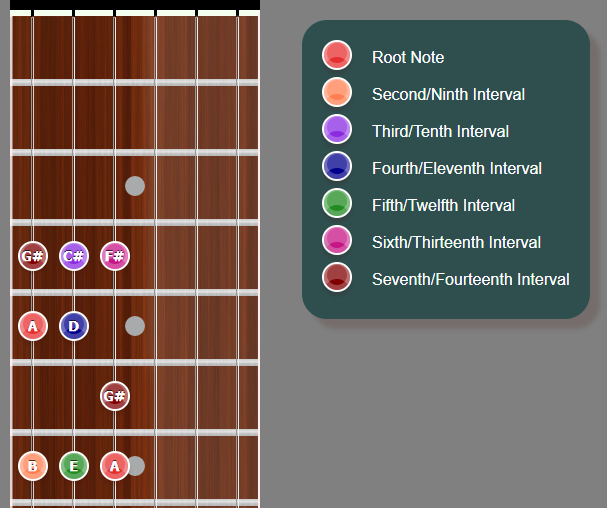
As we learned in the tutorial on How Chords are made, and also 5th Chords and Power Chords,
All chords are based off the Major Scale of that Chord's Root Note. Using the Major Pattern,
G#'s 5th would be where the white circle is located on the graphic below:

A G# Major Chord consists of G# - C - D#
The G#'s 5th would be a D#. This tells us to flatten the 5th, which gives us D.
The G#'s 7th would be a G. This is a minor 7th, so we flatten the 3rd and the 7th, which gives us F#.
So, the notes of a G#m7b5 are: G# - B - D - F#
This fits perfectly in the A Major Scale ( A - B - C# - D - E - F# - G# )
This completes the chords of the Key of A Major (or any Major Key)
Wrap Up
In this tutorial we went over the chords of the Major and Minor Scale. We went over the Major and Minor Chords,
as well as the Diminished Chord and why it's diminished.
We also went over the L Pattern/Method, where you can easily find which chords are Major, or Minor,
while you have the guitar in your hands, and even if you're playing the guitar at that time.
You may also notice that in our example, the F# Minor Scale and A Major Scale contain the same notes and chords.
That's because F# is the relative Minor for A Major.
As stated in the Relative Minor tutorial, the Relative Minor is 3 half steps (1 1/2 steps) down from the Major Root.
This means that we can use the L Method to find all the Chords in the Major Key. Or if we want the Relative Minor,
move the pattern down 3 frets.
Conversely, if we know the Minor Key, and want the Relative Major, we simply move the patter UP 3 half steps.
This means that we know how to know all the chords for any Major or Minor Scale, by simply knowing the root note.